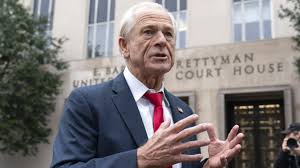Steve Bannon is set to serve prison time for contempt of Congress related to the January 6th investigation. Bannon’s “War Room” program has been a pivotal platform for disseminating American First concepts and strategies, significantly influencing the MAGA movement even after his departure from the White House.
What Bannon has done is created a grassroots marketing platform for MAGA- something Obama’s team was celebrated for in 2008, according to Ad Week.
Bannon has played a vital role in shaping the narrative and energizing the grassroots level of the Republican Party in a way that has never been done in memory and which directly mirrors what former President Barack Obama’s campaign did in 2008, as outlined in a book titled Groundbreakers.
IS THIS OBAMA OR BANNON?? KEEP READING
According to the book, Barack Obama’s 2008 campaign effectively utilized precinct captains to mobilize voters and secure his victory. This grassroots strategy was crucial in building a robust, on-the-ground operation that significantly impacted his electoral success. Here’s how the campaign used precinct captains:
1. Local Leadership and Community Engagement
Precinct captains were local leaders responsible for specific geographic areas, usually a few city blocks or a rural community. They were typically residents who knew their neighbors and community dynamics well. This local leadership was crucial in creating a personalized and persuasive campaign message.
2. Voter Identification and Outreach
Precinct captains were tasked with identifying potential Obama supporters within their precincts. They knocked on doors, made phone calls, and engaged in face-to-face conversations to understand voters’ concerns and persuade them to support Obama. This direct engagement helped the campaign identify supporters and undecided voters.
3. Volunteer Recruitment and Training
Captains recruited and organized local volunteers. They held training sessions to ensure volunteers were well-prepared to canvass neighborhoods, register voters, and effectively promote Obama’s message. This recruitment was essential in building a large and motivated volunteer base.
4. Data Collection and Utilization
Using advanced data analytics, precinct captains collected information on voter preferences, concerns, and likelihood of turning out to vote. This data was fed into the campaign’s central database, which allowed for targeted outreach and follow-up efforts. The campaign used this data-driven approach to allocate resources efficiently and tailor messages to specific voter segments.
5. Community Events and Campaign Activities
Precinct captains organized local events such as house parties, town hall meetings, and voter registration drives. These events created opportunities for community members to learn about Obama’s policies, ask questions, and get involved in the campaign. This grassroots mobilization fostered a sense of community and shared purpose among supporters.
6. Get Out the Vote (GOTV) Efforts
In the final days leading up to the election, precinct captains spearheaded GOTV efforts. They ensured that identified supporters had transportation to polling places, understood early voting options, and were reminded to vote on Election Day. This meticulous attention to turnout was critical in close races and helped maximize voter participation.
7. Feedback Loop to Campaign Headquarters
Precinct captains acted as a feedback mechanism for the central campaign office. They reported on local issues, voter sentiments, and the effectiveness of campaign messages. This information allowed the campaign to adjust its strategies and respond to emerging challenges promptly.
8. Building Long-term Political Infrastructure
The network of precinct captains and volunteers did not dissolve after the election. Instead, it became part of a lasting political infrastructure that could be mobilized for future elections and policy advocacy. This enduring grassroots network contributed to Obama’s continued political influence and the success of the Democratic Party in subsequent elections.
The Obama 2008 campaign’s use of precinct captains exemplified a highly organized and strategic approach to grassroots mobilization. By empowering local leaders, effectively utilizing data, and fostering community engagement, the campaign was able to build a broad and committed base of support that played a pivotal role in Obama’s victory. This grassroots organizing model has since been studied and emulated by political campaigns.
‘NOT SO AWESOME WHEN BANNON DOES IT’-THE MEDIA SCREAMS
Central to Bannon’s influence is the “precinct strategy,” which frightens his opponents and encourages MAGA supporters to assume control of local Republican Party operations through civic engagement.
So we know that the Precinct Project isn’t revolutionary because it is new; it was a large part of Obama’s 2008 campaign strategy. However, when Bannon drives people to do what the Democrats did in 2008, somehow, it is bone-chilling to the corporate media and the political establishment.
But there is no plan to stop that activity for MAGA, even as Bannon faces prison.
Bannon’s strategy aims to purge the party of “RINOs” (Republicans In Name Only) who are disloyal to Trump’s America First Agenda. By taking over these grassroots positions, Bannon’s followers have helped Trump reassert his dominance within the GOP, ensuring that the party remains aligned with his vision.
Trump’s opponents are furious about it, and this was the case for the panel on The Hive. This Vanity Fair podcast recently held a discussion about Bannon and his mission. Guests deconstructed Bannon’s use of the precinct project.
According to the panel of Hive guests, one who wrote a book titled Finish What We Started, who talked to host Brian Stelter, the establishment is growing concerned about the potential consequences of Bannon’s scary Precinct Project agenda.
But take a look at how scary it really is, from their site:
The Precinct Strategy is a grassroots effort to help people like you and me become Precinct Committeemen. Precinct Committeemen are voting members of the party who represent their community and make up the foundation of all political parties.
Fewer than one in one hundred political party members can be internal voting members, and parties cannot exist without the influence and power of these Precinct Committee members.
The goal of the Precinct Strategy is to help the Republican Party succeed in three ways by:
- Influencing the policies and overall direction of the Republican Party
- Deciding who represents the Republican Party when running for public office.
- Electing leaders of the Republican Party who truly represent the people.
PRETTY SCARY!
The Hive panel lamented Bannon’s repeated calls for “victory or death” without addressing Bannon’s constant historical references to America’s Founding, and even after he attributed the phrase to founding father and first President of the United States, General George Washington.
“Victory or death” is a powerful phrase associated with Washington during the American Revolutionary War. It reflects his unwavering commitment to the cause of independence. As the commander-in-chief of the Continental Army, Washington faced immense challenges and sacrifices. His determination and leadership played a crucial role in securing victory for the American colonies.
The panel turns to Bannon’s threats to jail political opponents, which have greatly disturbed the people who want to see Bannon demonized, locked away for good, and quieted.
By consistently delegitimizing the lawfare within the justice system, for example, The Hive guests say that Bannon is fostering an environment where the rule of law is undermined and political violence becomes a real threat.
Without addressing how Republican men charged with misdemeanors, like Bannon and Peter Navarro, are being imprisoned during a political campaign when Democrats charged with the same offense, face no consequences at all.
One of the Hive’s guests describes Bannon’s role as the “screaming Id” of the MAGA movement, saying that Bannon cannot be overstated, claiming that he vocalizes what many Trump allies may only privately contemplate, particularly regarding justice and the jailing of political adversaries who have worked outside of the US Constutition to hamper Trump’s agenda.
The panel sees Bannon’s political activism to drive people into civic engagement as “dangerous.”
Despite his impending imprisonment, the War Room podcast is expected to continue operating with guest hosts. This continuity underscores the podcast’s significance as a media hub for the MAGA movement, ensuring that Bannon’s influence endures even while behind bars.
The Hive panel discussed an intriguing aspect of Bannon’s strategy: his belief in “hidden MAGA voters.” These are individuals who, despite being disengaged from the political process, align with Trump’s ideology and can be mobilized to support the movement. As admitted in the podcast, some data supports this claim, suggesting that there is a reservoir of untapped support that could be crucial in future elections.
As Bannon heads to prison, his legacy within the MAGA movement will likely persist, fueled by the same passion for the American Republic that has propelled him thus far. His influence channeled through platforms like the War Room program, will continue to shape the contours of American politics, with ramifications that extend far beyond his prison sentence.





I learned something new today, and it’s all thanks to this post!
Steve will prevail, even in jail! He won’t be silenced!